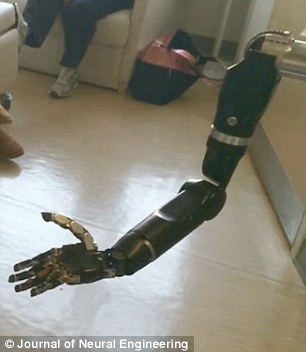
The robotic arm initially had 76 percent accuracy. Once the ring and pinkie fingers were coupled together the accuracy rose to 88 percent.
A team of researchers at the Johns Hopkins University School of Medicine has demonstrated the first ever mind-controlled robotic arm able to successfully move individual fingers through thoughts. The feat, which was described online this week in the Journal of Neural Engineering, describes a huge advance in the technology that could restore fine-motor hand function to those who have lost arms.
Nathan Crone, senior author of the study, stated in a press release that the technology goes beyond the capabilities of current prostheses, in which the fingers move as a single unit in a grabbing-type motion. The new device allowed the subject to successfully wiggle fingers independently, without extensive training for the user.
The subject testing the arm was not missing a limb, but was equipped with a device that bypassed control of his own arm and hand through a brain-mapping procedure. The man, who has epilepsy, was already at the hospital for brain mapping in order to pinpoint the origin of his seizures.
Before the prosthesis was connected, the researchers mapped and tracked the specific areas of the man’s brain that were responsible for moving each finger. The robotic arm was then programmed to move the corresponding fingers. The computer program the team developed had the man moving individual digits on command, while recording which parts of the brain were activated when each sensor detected a signal.
After collecting the sensory and motor data, the researchers programmed the arm to move individual fingers according to which part of the brain was active. The arm, which was wired to the patient via brain electrodes, was turned on, and the man was asked to think about individually moving his fingers and thumb. Electrical activity in the brain moved the fingers.
The robotic arm initially had 76 percent accuracy. Once the ring and pinkie fingers were coupled together the accuracy rose to 88 percent. Crone says that the part of the brain controlling the ring and pinkie fingers overlaps, and most people actually move the two together.
The news of the mind-controlled prosthetic has come on the heels of an announcement of a bionic spine that attempts to allow people to control robotic limbs with subconscious thoughts. Crone says that making the technology available to people who are actually missing limbs is still years off, and will be costly. The Amputee Coalition says that most of the 100,000 people living in the U.S. who are missing hands or arms could potentially benefit from the new technology.

Leave a Reply